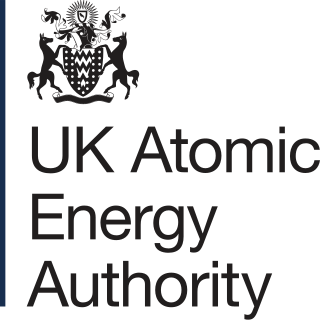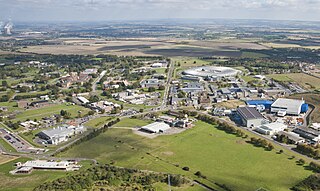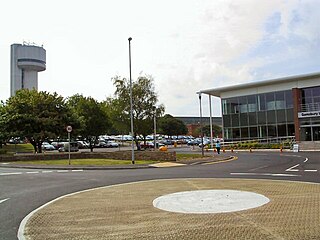
The Council for the Central Laboratory of the Research Councils (CCLRC) was a UK government body that carried out civil research in science and engineering.

Diamond Light Source is the UK's national synchrotron light source science facility located at the Harwell Science and Innovation Campus in Oxfordshire.

The Particle Physics and Astronomy Research Council (PPARC) was one of a number of research councils in the United Kingdom. It directed, coordinated and funded research in particle physics and astronomy for the people of the UK. Its head office was at Polaris House in Swindon, Wiltshire, but it also operated three scientific sites: the UK Astronomy Technology Centre in Edinburgh, the Isaac Newton Group of Telescopes (ING) in La Palma and the Joint Astronomy Centre (JAC) in Hawaii. It published the Frontiers magazine three times a year, containing news and highlights of the research and outreach programmes it supports.

The United Kingdom Atomic Energy Authority is a UK government research organisation responsible for the development of fusion energy. It is an executive non-departmental public body of the Department for Energy Security and Net Zero (DESNZ).
The Science and Engineering Research Council (SERC) and its predecessor the Science Research Council (SRC) were the UK agencies in charge of publicly funded scientific and engineering research activities, including astronomy, biotechnology and biological sciences, space research and particle physics, between 1965 and 1994.

The Rutherford Appleton Laboratory (RAL) is one of the national scientific research laboratories in the UK operated by the Science and Technology Facilities Council (STFC). It began as the Rutherford High Energy Laboratory, merged with the Atlas Computer Laboratory in 1975 to create the Rutherford Lab; then in 1979 with the Appleton Laboratory to form the current laboratory.
The Engineering and Physical Sciences Research Council (EPSRC) is a British Research Council that provides government funding for grants to undertake research and postgraduate degrees in engineering and the physical sciences, mainly to universities in the United Kingdom. EPSRC research areas include mathematics, physics, chemistry, artificial intelligence and computer science, but exclude particle physics, nuclear physics, space science and astronomy. Since 2018 it has been part of UK Research and Innovation, which is funded through the Department for Business, Energy and Industrial Strategy.

The ISIS Neutron and Muon Source is a pulsed neutron and muon source, established 1984 at the Rutherford Appleton Laboratory of the Science and Technology Facilities Council, on the Harwell Science and Innovation Campus in Oxfordshire, United Kingdom. It uses the techniques of muon spectroscopy and neutron scattering to probe the structure and dynamics of condensed matter on a microscopic scale ranging from the subatomic to the macromolecular.
George Ernest Kalmus, CBE, FRS is a noted British particle physicist.

Research Councils UK, sometimes known as RCUK, was a non-departmental public body that coordinated science policy in the United Kingdom from 2002 to 2018. It was an umbrella organisation that coordinated the seven separate research councils that were responsible for funding and coordinating academic research for the arts, humanities, science and engineering. In 2018 Research Councils transitioned into UK Research and Innovation (UKRI).

Daresbury Laboratory is a scientific research laboratory based at Sci-Tech Daresbury campus near Daresbury in Halton, Cheshire, England. The laboratory began operations in 1962 and was officially opened on 16 June 1967 as the Daresbury Nuclear Physics Laboratory (DNPL) by the then Prime Minister of United Kingdom, Harold Wilson. It was the second national laboratory established by the British National Institute for Research in Nuclear Science, following the Rutherford High Energy Laboratory. It is operated by the Science and Technology Facilities Council, part of UK Research and Innovation. As of 2018, it employs around 300 staff, with Paul Vernon appointed as director in November 2020, taking over from Professor Susan Smith who had been director from 2012.

The Atlas Computer Laboratory on the Harwell, Oxfordshire campus shared by the Harwell Laboratory was one of the major computer laboratories in the world, which operated between 1961 and 1975 to provide a service to British scientists at a time when powerful computers were not usually available. The main user population was the UK universities and some government agencies.

The Harwell Science and Innovation Campus is a 700-acre science and technology campus in Oxfordshire, England. Over 6,000 people work there in over 240 public and private sector organisations, working across sectors including Space, Clean Energy, Life Sciences and Quantum Computing.
The United Kingdom Space Agency (UKSA) is an executive agency of the Government of the United Kingdom, responsible for the United Kingdom's civil space programme. It was established on 1 April 2010 to replace the British National Space Centre (BNSC) and took over responsibility for government policy and key budgets for space exploration; it represents the United Kingdom in all negotiations on space matters. The Agency "[brings] together all UK civil space activities under one single management". It is based at the former BNSC headquarters in Swindon, Wiltshire.
NINA (Northern Institute's Nuclear Accelerator) was a particle accelerator located at Daresbury Laboratory, UK that was used for particle physics and as a source of synchrotron radiation.

The Hartree Centre is a high performance computing, data analytics and artificial intelligence (AI) research facility focused on industry-led challenges. It was formed in 2012 at Daresbury Laboratory on the Sci-Tech Daresbury science and innovation campus in Cheshire, UK. The Hartree Centre is part of the Science and Technology Facilities Council (STFC) which itself is part of United Kingdom Research and Innovation (UKRI).
Andrew Dawson Taylor was director of the Science and Technology Facilities Council National Laboratories – Rutherford Appleton Laboratory, Daresbury Laboratory, and the UK Astronomy Technology Centre in Edinburgh until his retirement in 2019.

John Simpson is a British nuclear physicist. He is known for his work in gamma-ray spectroscopy and detector design. He was Head of Technology, Division of Technology Department. and was Head of the Nuclear Physics Group at STFC Daresbury Laboratory. He is a visiting professor of physics at the University of Liverpool.
The National Institute for Research in Nuclear Science was a UK Government establishment that provided equipment and facilities for nuclear research that would otherwise be beyond the financial capability of individual universities and other nuclear research establishments. It operated from 1957 to 1965.












